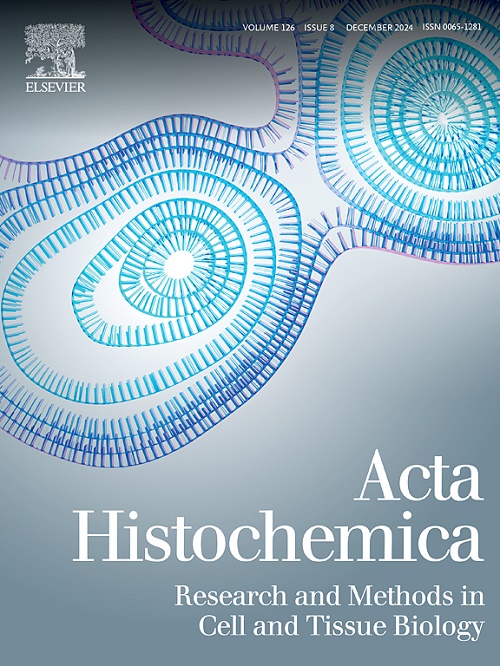Lysophosphatidic acid (LPA) receptor signaling enhances malignant potential in highly migratory lung cancer cells under hypoxic conditions
IF 2.4
4区 生物学
Q4 CELL BIOLOGY
引用次数: 0
Abstract
Hypoxia contributes to tumor progression, promoting cancer cell motility, invasion and metastasis. Lysophosphatidic acid (LPA) receptors are implicated in the pathogenesis of cancer. In this study, we investigated the role of LPA receptor signaling in modulating malignant behavior under hypoxic conditions (1 % O2) in lung cancer cells. We generated highly migratory A549-R12 cells from the parental lung cancer A549 cells for this purpose. LPAR1 and LPAR2 expression levels were lower in both A549 and A549-R12 cells cultured at 1 % O2 compared to those cultured at 21 % O2, while LPAR3 expression remained unchanged between the two cell lines. Cell motility increased in both A549 and A549-R12 cells cultured at 1 % O2. Notably, A549-R12 cells exhibited greater motility under 1 % O2 conditions than A549 cells. Treatment with AM966 (an LPA1 antagonist) and (2S)-OMPT (an LPA3 agonist) further increased the motility of A549-R12 cells, while GRI-977143 (an LPA2 agonist) decreased their motility. Moreover, the invasion activity of A549-R12 cells was higher than that of A549 cells, with 1 % O2 conditions significantly enhancing A549-R12 cell invasion. AM966 and (2S)-OMPT stimulated, whereas GRI-977143 inhibited, the invasion of A549-R12 cells. In the presence of LPA, cell viability to cisplatin (CDDP) was higher in A549-R12 cells cultured at both 21 % and 1 % O2 compared to A549 cells. These results suggest that LPA receptor signaling plays a key role in regulating malignant progression in highly migratory lung cancer cells under hypoxic conditions.
溶血磷脂酸(LPA)受体信号在缺氧条件下增强高迁移肺癌细胞的恶性潜能
缺氧有助于肿瘤的进展,促进癌细胞的运动、侵袭和转移。溶血磷脂酸(LPA)受体与癌症的发病机制有关。在这项研究中,我们研究了LPA受体信号在低氧条件下(1 % O2)在肺癌细胞中调节恶性行为的作用。为此,我们从亲代肺癌A549细胞中产生了高度迁移的A549- r12细胞。在1 % O2下培养的A549和A549- r12细胞中,LPAR1和LPAR2的表达水平低于在21 % O2下培养的细胞,而LPAR3的表达在两种细胞系之间保持不变。在1 % O2条件下培养的A549和A549- r12细胞的细胞活力均增加。值得注意的是,A549- r12细胞在1 % O2条件下比A549细胞表现出更大的运动性。AM966 (LPA1拮抗剂)和(2S)-OMPT (LPA3激动剂)进一步增加了A549-R12细胞的运动性,而GRI-977143 (LPA2激动剂)降低了它们的运动性。此外,A549- r12细胞的侵袭活性高于A549细胞,1 % O2条件显著增强A549- r12细胞的侵袭活性。AM966和(2S)-OMPT刺激A549-R12细胞的侵袭,而GRI-977143抑制A549-R12细胞的侵袭。在LPA存在的情况下,与A549细胞相比,在21 %和1 % O2下培养的A549- r12细胞对顺铂(CDDP)的存活率更高。这些结果表明LPA受体信号在缺氧条件下调节高迁移性肺癌细胞的恶性进展中起关键作用。
本文章由计算机程序翻译,如有差异,请以英文原文为准。
求助全文
约1分钟内获得全文
求助全文
来源期刊

Acta histochemica
生物-细胞生物学
CiteScore
4.60
自引率
4.00%
发文量
107
审稿时长
23 days
期刊介绍:
Acta histochemica, a journal of structural biochemistry of cells and tissues, publishes original research articles, short communications, reviews, letters to the editor, meeting reports and abstracts of meetings. The aim of the journal is to provide a forum for the cytochemical and histochemical research community in the life sciences, including cell biology, biotechnology, neurobiology, immunobiology, pathology, pharmacology, botany, zoology and environmental and toxicological research. The journal focuses on new developments in cytochemistry and histochemistry and their applications. Manuscripts reporting on studies of living cells and tissues are particularly welcome. Understanding the complexity of cells and tissues, i.e. their biocomplexity and biodiversity, is a major goal of the journal and reports on this topic are especially encouraged. Original research articles, short communications and reviews that report on new developments in cytochemistry and histochemistry are welcomed, especially when molecular biology is combined with the use of advanced microscopical techniques including image analysis and cytometry. Letters to the editor should comment or interpret previously published articles in the journal to trigger scientific discussions. Meeting reports are considered to be very important publications in the journal because they are excellent opportunities to present state-of-the-art overviews of fields in research where the developments are fast and hard to follow. Authors of meeting reports should consult the editors before writing a report. The editorial policy of the editors and the editorial board is rapid publication. Once a manuscript is received by one of the editors, an editorial decision about acceptance, revision or rejection will be taken within a month. It is the aim of the publishers to have a manuscript published within three months after the manuscript has been accepted
 求助内容:
求助内容: 应助结果提醒方式:
应助结果提醒方式:


